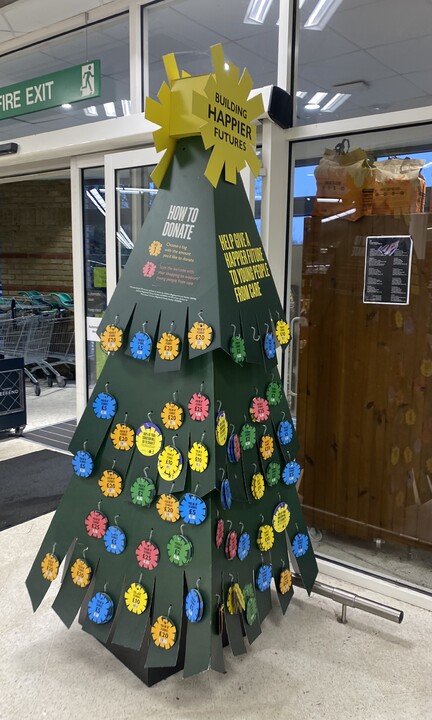If we look beyond believing success in CX is about setting a sentiment score target and achieving it we can arrive at some incredible outcomes which improve society. The narrowcast view for customer experience is to create better outcomes for those close; customers, employees and the sustainable business. But the truth is the real power from CX can be found when we go beyond business to think about helping others outside these groups who have a greater need.
In recent weeks I’ve seen several excellent examples of organisations who have reinforced their commitment to helping others. They’ve done this by providing experiences for those communities, through their own experience footprint.

The image above shows a Waitrose supermarket (UK) initiative in my local store. You will notice the prime door entrance marketing positioning during the Christmas period is afforded to promote a ‘giving’ tree, encouraging its customers to donate to give others an improved Christmas. Without creating friction to the shopping experience, customers can add a giving experience alongside their other purchases making the payment experience simple too.
The UK based supermarket Morrisons have pledged 160,000 meals to those who are struggling to support themselves. Those in need ask for ‘Henry’ at the cafe counter and they are served with a jacket potato, beans and salad. A report testing the validity of the initiative observed someone requesting a Henry meal. She stated the staff “couldn’t have been kinder” and the whole process was “easy, straightforward and discreet”.
She added: “As I was eating my meal I noticed an elderly man go to the till and also order a Henry for himself, he was treated with the same level of kindness and customer service as I had been.
In the Netherlands, supermarket Jumbo have turned the tide on ‘speed at till’, and created a slow lane which allows customers to stop and chat to the counter retail staff. They recognise that for some groups in society who are isolated due to age or other reasons, the supermarket can be their only form of conversation. Replacing it with a self-scanner might meet efficiency targets, but it fails to be socially inclusive.

To reach these heights requires a customer centric mindset, which is sadly compromised when the focus is a score on a dashboard. Coincidentally, these are all retail examples. A sector not regulated by CSaT or NPS scores, as some such as energy and financial services are sector are. I believe it makes a difference to the motivation.
A better outcome is not an ‘8’, or 30% NPS. That is a score. A better outcome is an improved life, in some small or large part. All three examples achieve deep-rooted memories for the benefactors, that someone was looking out for them. Not something a single-minded scoring model as a measure of success in CX will ever recognise.
Call it ‘6 stars’, call it ‘one more lap’, ‘call it beyond business’, call it as you will. But I encourage you to push through the finish line of ‘the score we’re aiming for’ and seek opportunities to help a wider community with your CX endeavours. CX is about helping others, live it.
When you consider success from customer experience, do you think in terms of KPIs and targets, or do you visualise the lives of the people improved by your endeavours? Featuring three great examples from Morrisons, Waitrose & Partners and Jumbo Supermarkten. hashtag#customerexperience hashtag#beneficiary hashtag#makingadifference


